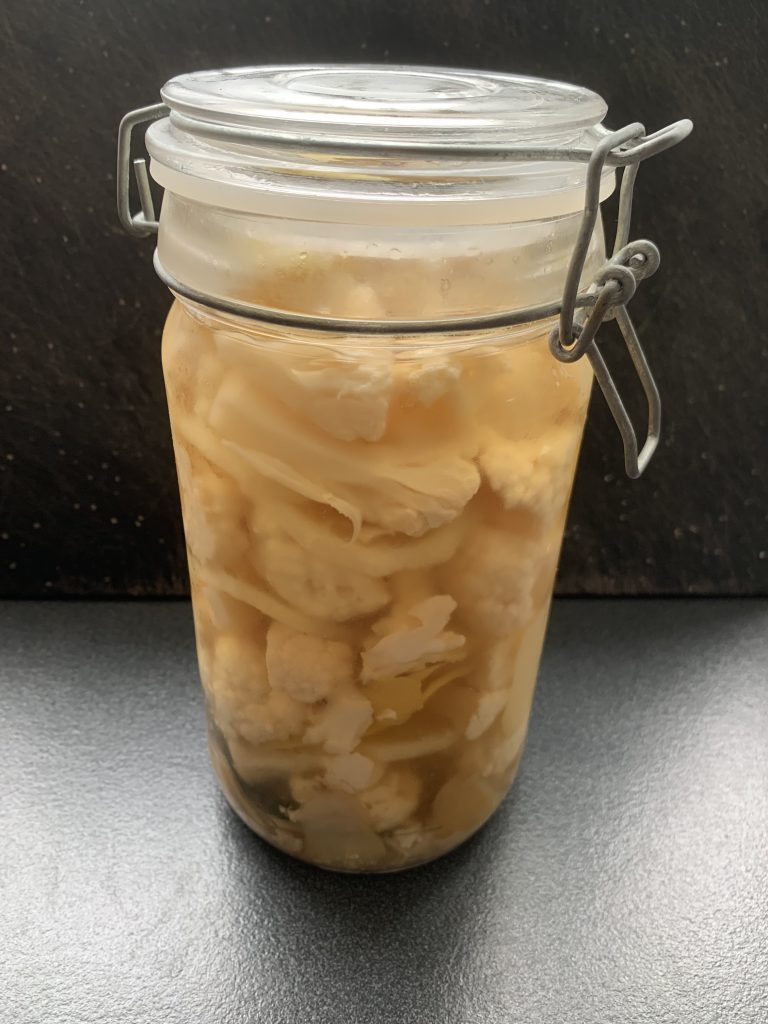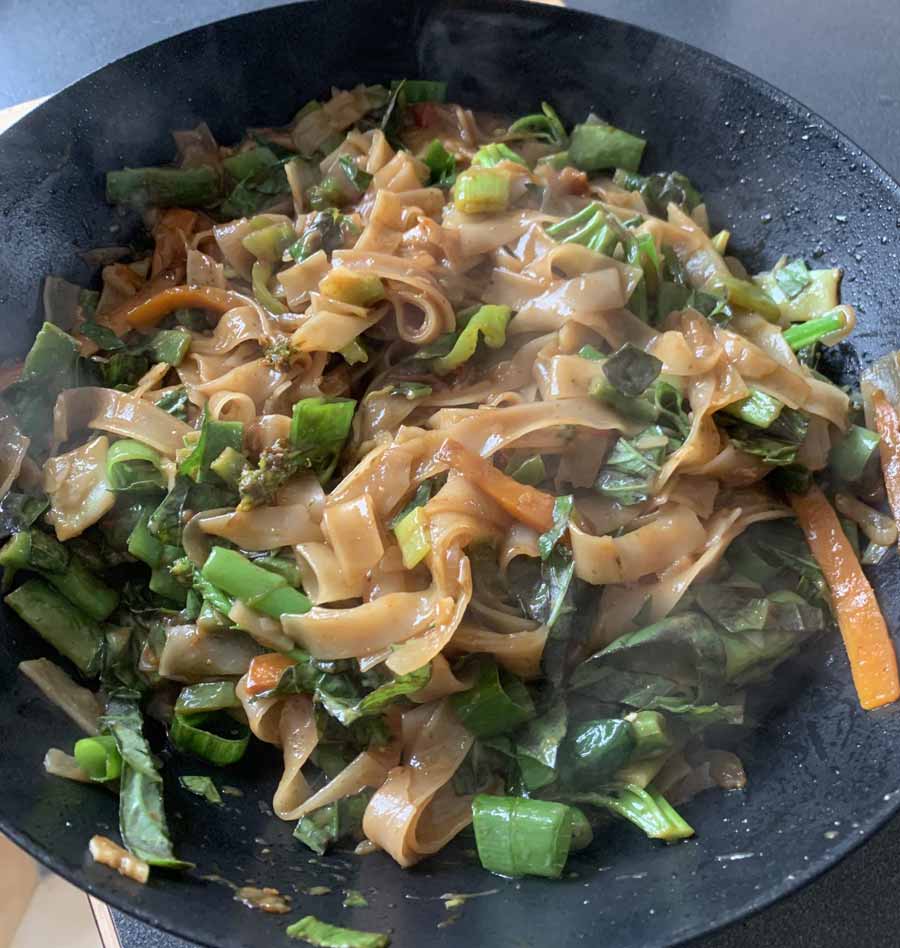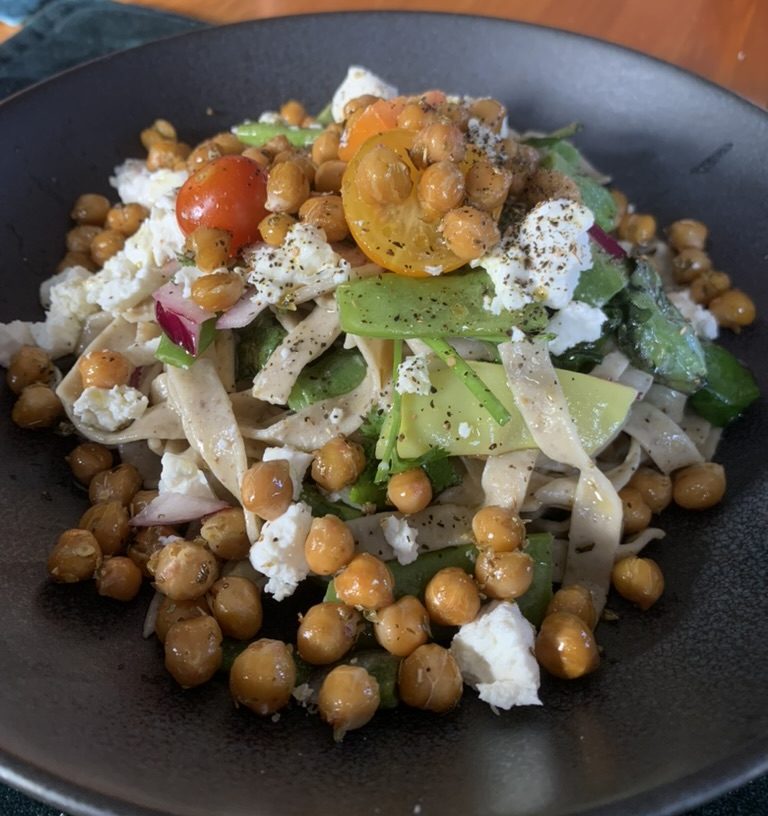author
Jacques Lawinski
post
- 26/02/2023
- No Comments
- Food
share
A delicious pickled cauliflower to put on rice, in salads, or as a side to almost any meal!

Ingredients
1/2 head of cauliflower
1 cup apple cider vinegar
1.5 cups water
2 tsp salt
1 lemon
1/2 tsp peppercorns
Method
- Cut up the cauliflower into small pieces, trying to keep the florets together so you have pieces that are easy to take out when it’s finished. Slice up the garlic, and cut slices of lemon rind off the lemon with a sharp knife. Slice up the remaining lemon into thin slices.
- In a medium-sized pan, put the water, vinegar and salt together and bring to the boil.
- Add the cauliflower florets and leave to boil for 5 minutes.
- Take off the heat, and in a large glass jar, add some slices of lemon and some pieces of lemon zest. Top this with some pieces of cauliflower from the pot.
- Continue making layers in this way, and about halfway, add in some of the garlic and peppercorns. Finish with a layer of lemon slices on the top.
- Fill up the jar to the top with the liquid left over in the pan. Use enough to cover the cauliflower completely.
- Let it cool down at room temperature, then put the lid on and put it in the fridge. The pickle will be ready to eat in around 48 hours, but it gets better and more lemony with time!!
Our food section provides ideas and inspiration for great, fresh food. Our recipes will always be open and free for everyone to use, without any advertising.
All our articles are freely accessible because we believe that everyone needs to be able to access to a source of coherent and easy to understand information on the ecological crisis. By eating well, and in ways that have a better impact on the environment, we can begin to change the way the whole society produces food.
If you've learned something today, or feel inspired, please consider donating, to help us produce more great recipes and share this knowledge with a wider audience.
Why plurality.eco?
Our environment is more than a resource to be exploited. Human beings are not the ‘masters of nature,’ and cannot think they are managers of everything around them. Plurality is about finding a wealth of ideas to help us cope with the ecological crisis which we have to confront now, and in the coming decades. We all need to understand what is at stake, and create new ways of being in the world, new dreams for ourselves, that recognise this uncertain future.
Vegan ‘nduja paste
author
Jacques Lawinski
post
- 04/02/2023
- No Comments
- Food
share
Originally a spicy Italian salami paste used in sauces, dressings, salads, pasta, and more, this umami-filled vegetarian/vegan version is absolutely brilliant with watermelon and feta cheese as a salad, or in a tomato sauce with fresh pasta to add an extra kick of spice and flavour.

Ingredients
45 grams of sundried tomatoes (not in oil)
1 clove of garlic
1 tsp smoked paprika
2 heaped tsp miso paste
1 tsp fennel seeds
1/2 hungarian wax chilli, or two birdseye chillis, or chilli to taste
1 tbsp red wine vinegar
1 tbsp neutral oil like sunflower oil
Method
- Soak the dried sundried tomatoes in 1/4 cup boiling hot water for about 30 minutes.
- Cut up the chilli and garlic into fine slices, and then put into a blender or small food processor, along with the other ingredients including the tomatoes and the water.
- Mix together until you get a smooth paste.
- Store in the fridge until you need to use it!
Our food section provides ideas and inspiration for great, fresh food. Our recipes will always be open and free for everyone to use, without any advertising.
All our articles are freely accessible because we believe that everyone needs to be able to access to a source of coherent and easy to understand information on the ecological crisis. By eating well, and in ways that have a better impact on the environment, we can begin to change the way the whole society produces food.
If you've learned something today, or feel inspired, please consider donating, to help us produce more great recipes and share this knowledge with a wider audience.
Why plurality.eco?
Our environment is more than a resource to be exploited. Human beings are not the ‘masters of nature,’ and cannot think they are managers of everything around them. Plurality is about finding a wealth of ideas to help us cope with the ecological crisis which we have to confront now, and in the coming decades. We all need to understand what is at stake, and create new ways of being in the world, new dreams for ourselves, that recognise this uncertain future.
Pad kee mao
author
Jacques Lawinski
post
- 30/01/2023
- No Comments
- Food
share
A delicious Thai-inspired dish that has been made vegan by making your own oyster sauce and fish sauce, and using tofu as your protein! The fresh basil takes it to another level, a great crowd-pleaser!

Ingredients
Serves 4
Vegan oyster sauce:
10 dried shiitake mushrooms, soaked in 2 cups water
1 tbsp finely chopped ginger
1 tbsp oil
1/2 cup coconut aminos
8 pitted dates
Vegan fish sauce:
1 cup water
3 tbsp dulse (seaweed pieces)
2 tsp salt
1/4 cup dried shiitake mushrooms
1 tsp miso
1 tbsp tamari (or soy sauce)
Pad kee mao sauce:
4 tbsp vegan oyster sauce
1/3 cup soy sauce
2 tsp vegan fish sauce
2 tsp brown sugar
2 tbsp water
1 tsp chilli sauce/fresh chilli
Noodles:
200g wide rice noodles
2 tbsp oil
2 shallots, or one onion
1 carrot, thinly sliced
200g firm tofu
4 cloves of garlic, chopped
1 courgette, sliced
1 small capsicum, sliced
2 spring onions, thinly sliced
1 tomato, chopped
1 cup of Thai basil, or regular basil, chopped
Method
For the vegan oyster sauce:
- Soak the shiitake mushrooms in warm water for around 4 hours, until soft. Take them out of the bowl, squeeze out the water, and then thinly slice them. Strain the remaining water to remove any dirt.
- In a hot pan, heat up the oil. Then add the sliced mushrooms, ginger, and a pinch of salt. Sautée for about 4 minutes.
- Add a tablespoon of the coconut aminos to the mushrooms in the pan. Take off the heat after one minute.
- Put the mushrooms and ginger, the soaking water, the dates, and the rest of the coconut aminos in a blender and mix for a minute or so until you end up with a smooth liquid. Set aside to use later.
For the vegan fish sauce:
- In a saucepan, add the water, dried mushrooms, salt, and the dulse. Heat until boiling and leave to cook for 15 minutes on a low heat.
- Remove from the heat, and let it cool slightly. Pour the mixture through a sieve, and squeeze out the juice from the mushrooms and the seaweed.
- To the bowl with the liquid, add in the miso paste and the tamari. Mix these in to the sauce. Set aside to use later.
The noodles
- Prepare all the vegetables by slicing everything up and putting them in piles on your chopping board to use. The secret to this is being able to cook everything quickly in a hot wok or frying pan.
- Mix the ingredients for the sauce in a separate bowl and set aside.
- Heat up a pot of boiling water for the noodles, and when you are ready to cook the vegetables, put the noodles in the boiling water.
- In a wok, add one tablespoon of oil and heat until hot. Add the shallots/onions and the carrots, and cook for two minutes. Then add some more oil, and add the tofu. Cook until the tofu is golden brown.
- Add the vegetables and the garlic and cook for another two minutes.
- Strain the noodles when they are cooked, and add them to the frying pan on top of the noodles. Pour the sauce on top, and then mix the sauce into the vegetables and noodles. Stir until well mixed through.
- Take off the heat, and add the chopped basil, then serve!
Our food section provides ideas and inspiration for great, fresh food. Our recipes will always be open and free for everyone to use, without any advertising.
All our articles are freely accessible because we believe that everyone needs to be able to access to a source of coherent and easy to understand information on the ecological crisis. By eating well, and in ways that have a better impact on the environment, we can begin to change the way the whole society produces food.
If you've learned something today, or feel inspired, please consider donating, to help us produce more great recipes and share this knowledge with a wider audience.
Why plurality.eco?
Our environment is more than a resource to be exploited. Human beings are not the ‘masters of nature,’ and cannot think they are managers of everything around them. Plurality is about finding a wealth of ideas to help us cope with the ecological crisis which we have to confront now, and in the coming decades. We all need to understand what is at stake, and create new ways of being in the world, new dreams for ourselves, that recognise this uncertain future.
Spelt pasta with green beans, red onion and chickpeas
author
Jacques Lawinski
post
- 25/01/2023
- No Comments
- Food
share
A delicious way to include home-grown green beans if you’ve got too many, and a perfect pasta salad for a warm lunchtime or dinner meal together.

Ingredients
Serves 4-6
Spelt pasta:
3 cups of white spelt flour
1/4 cup pumpkin seed flour (can omit if you don’t have it)
1 tbsp chia seed flour
cold water
Sauce:
1/4 cup extra virgin olive oil
4 cloves of garlic, sliced
1/2 large red onion
3/4 tin chickpeas, drained and washed
handful of fresh basil leaves
handful of coriander leaves
two handfuls of green beans
2 tbsp lime juice (add more if you like this lime flavour!)
salt and pepper to taste
optional: feta cheese or parmesan, cherry tomatoes on top
Method
For the pasta:
- Mix together the spelt flour and pumpkin seed flour in a large bowl.
- Create a ‘chia egg’ by mixing the chia seed flour with about 1/4 cup of water until you get a thick paste. Add this to the flours.
- Mix in the chia liquid with your hands into the flour. Start by adding flour on top of the chia, and mix it in, slowly adding more flour from around the sides of the bowl.
- Add more water once the chia egg is well mixed in, until you get a dry dough texture.
- Knead the dough vigorously for about 5 minutes until it springs back when pushed with your finger.
- Let the dough rest, covered, for 30 minutes.
- Uncover the dough, and break off about 1/6 of it. If you have a pasta machine, use this to roll out and cut the piece of dough. Otherwise, using a rolling pin on a floured surface, roll out the pasta sheet to about 3mm thick, and then fold it in half and roll it out some more. Continue this method of folding in half four times.
- Roll out the pasta until it is about 1mm thick. It should hold its structure well, but not be so thin that it tears. Generally a bit see-through is perfect.
- Cut the piece into long strips, like tagliatelle, or wider strips, if you want parpadelle pasta. Repeat for the rest of the dough.
For the sauce:
- If you have the oven on already, put the chickpeas in a roasting tin with some olive oil, salt, and a few of the herbs. Bake until crisp. Otherwise, in a saucepan heat up some of the olive oil and add the chickpeas, salt, and herbs. Cook them until they start to go golden brown and begin to crisp up.
- Meanwhile, prepare the beans by cutting them into 3cm pieces. Using a steamer or just some water in a pan and a sieve on top, steam the beans for about 5 minutes or until tender. Don’t overcook them – some crunch is good!
- Transfer the chickpeas to a bowl. In the same pan, add the remaining olive oil, the sliced garlic, and some torn up basil leaves. Fry this on a low heat until the garlic and the basil go crisp. Add the lime juice and stir.
- Chop up the remaining basil and coriander into rough pieces. Also finely slice the red onion and add these to a bowl.
Finishing
- Heat up a large pot of water until boiling. Once it is on a rolling boil, add a pinch of salt to the water. Then add the pasta, and cook for about 3 minutes, or until ‘al dente’.
- Strain the pasta, and add a glug of olive oil and stir through to stop the pasta from sticking. In a large bowl, add the pasta, the beans, the herbs, the red onion, and then pour over the sauce. Add some salt and pepper to taste, and then mix your pasta salad together carefully to coat the pasta in the sauce.
- Plate up with the chickpeas on top, adding cheese and tomatoes if you like!
Our food section provides ideas and inspiration for great, fresh food. Our recipes will always be open and free for everyone to use, without any advertising.
All our articles are freely accessible because we believe that everyone needs to be able to access to a source of coherent and easy to understand information on the ecological crisis. By eating well, and in ways that have a better impact on the environment, we can begin to change the way the whole society produces food.
If you've learned something today, or feel inspired, please consider donating, to help us produce more great recipes and share this knowledge with a wider audience.
Why plurality.eco?
Our environment is more than a resource to be exploited. Human beings are not the ‘masters of nature,’ and cannot think they are managers of everything around them. Plurality is about finding a wealth of ideas to help us cope with the ecological crisis which we have to confront now, and in the coming decades. We all need to understand what is at stake, and create new ways of being in the world, new dreams for ourselves, that recognise this uncertain future.



